Economics Report: UK Financial Crisis and Economic Policies Analysis
VerifiedAdded on 2020/06/04
|12
|2127
|53
Report
AI Summary
This economics report delves into key economic principles, starting with an analysis of externalities, including marginal external benefits and the implications of government intervention. It explores the production levels of firms with and without intervention, along with the socially optimal output and welfare implications. The report then investigates macroeconomic concepts, such as the equilibrium level of national income, the expenditure multiplier, and the impact of government expenditure and tax changes on achieving full employment. Furthermore, the report examines the relationship between unemployment and inflation, discussing the possibility of reducing unemployment without increasing inflation, supported by diagrams. Finally, it provides a critical evaluation of the UK's response to the 2007-2009 financial crisis, analyzing the effectiveness of monetary and fiscal policies implemented during that period, referencing relevant literature and data.
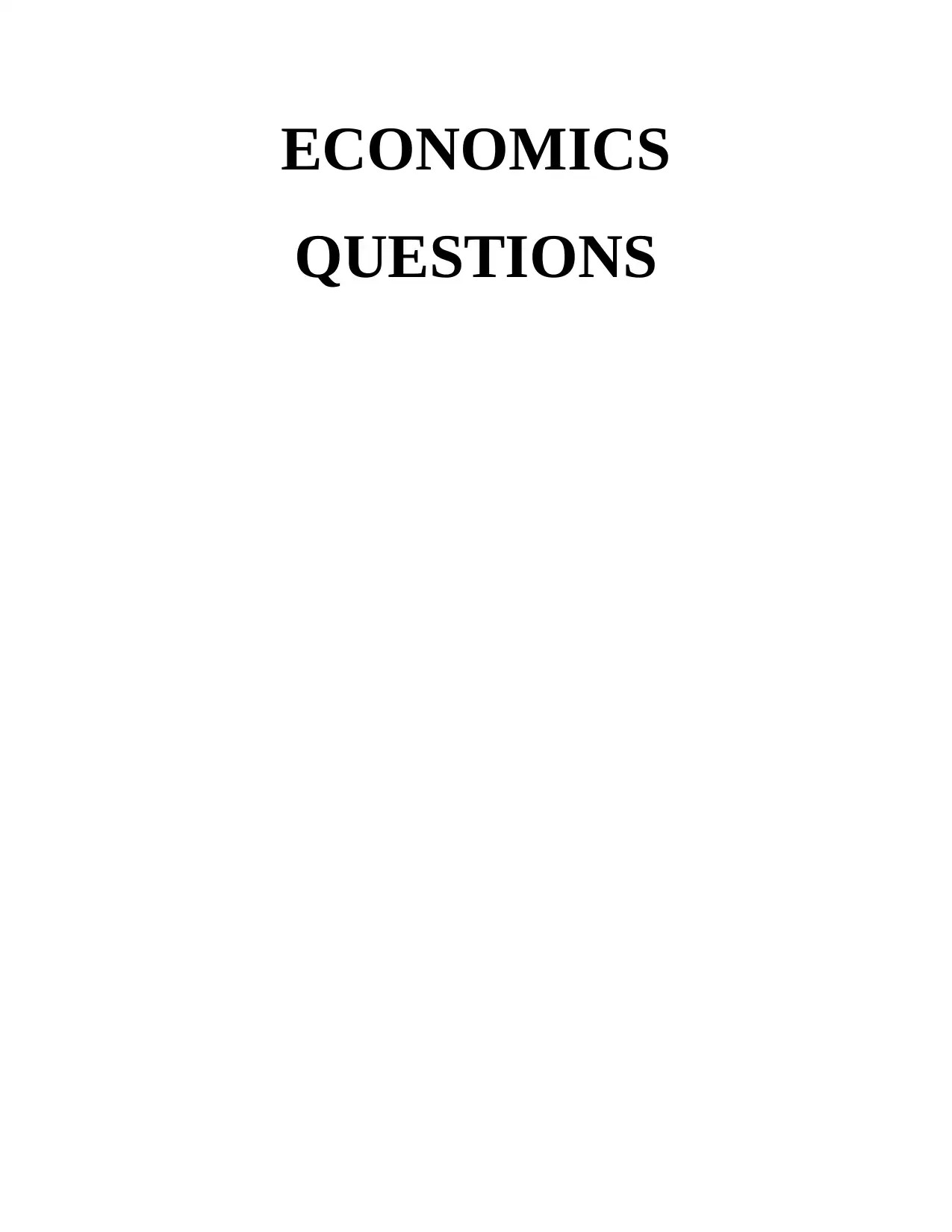
ECONOMICS
QUESTIONS
QUESTIONS
Paraphrase This Document
Need a fresh take? Get an instant paraphrase of this document with our AI Paraphraser

TABLE OF CONTENTS
INTRODUCTION...........................................................................................................................1
QUESTION 1...................................................................................................................................1
(a) Types of externalities.............................................................................................................1
(b) How much firm would be producing with no government intervention?.............................1
(c) Socially optimum level of output..........................................................................................2
(d) Welfare lost without government intervention......................................................................3
(e) Subsidy per units....................................................................................................................3
(f) Farming technology...............................................................................................................3
QUESTION 2...................................................................................................................................3
(a) Filling the value.....................................................................................................................3
(b) Equilibrium level of national income....................................................................................3
(c) Expenditure multiplier...........................................................................................................4
(d) Government expenditure.......................................................................................................4
(e) Equilibrium............................................................................................................................5
(f) Changing taxes.......................................................................................................................5
QUESTION 3...................................................................................................................................5
Discussing whether it is possible in reducing unemployment without increasing inflation
using diagram..............................................................................................................................5
QUESTION 4...................................................................................................................................6
Explaining the policy that is responding to financial crisis in UK and critically evaluating it
with use of theory and evidence..................................................................................................6
REFERENCES................................................................................................................................7
INTRODUCTION...........................................................................................................................1
QUESTION 1...................................................................................................................................1
(a) Types of externalities.............................................................................................................1
(b) How much firm would be producing with no government intervention?.............................1
(c) Socially optimum level of output..........................................................................................2
(d) Welfare lost without government intervention......................................................................3
(e) Subsidy per units....................................................................................................................3
(f) Farming technology...............................................................................................................3
QUESTION 2...................................................................................................................................3
(a) Filling the value.....................................................................................................................3
(b) Equilibrium level of national income....................................................................................3
(c) Expenditure multiplier...........................................................................................................4
(d) Government expenditure.......................................................................................................4
(e) Equilibrium............................................................................................................................5
(f) Changing taxes.......................................................................................................................5
QUESTION 3...................................................................................................................................5
Discussing whether it is possible in reducing unemployment without increasing inflation
using diagram..............................................................................................................................5
QUESTION 4...................................................................................................................................6
Explaining the policy that is responding to financial crisis in UK and critically evaluating it
with use of theory and evidence..................................................................................................6
REFERENCES................................................................................................................................7
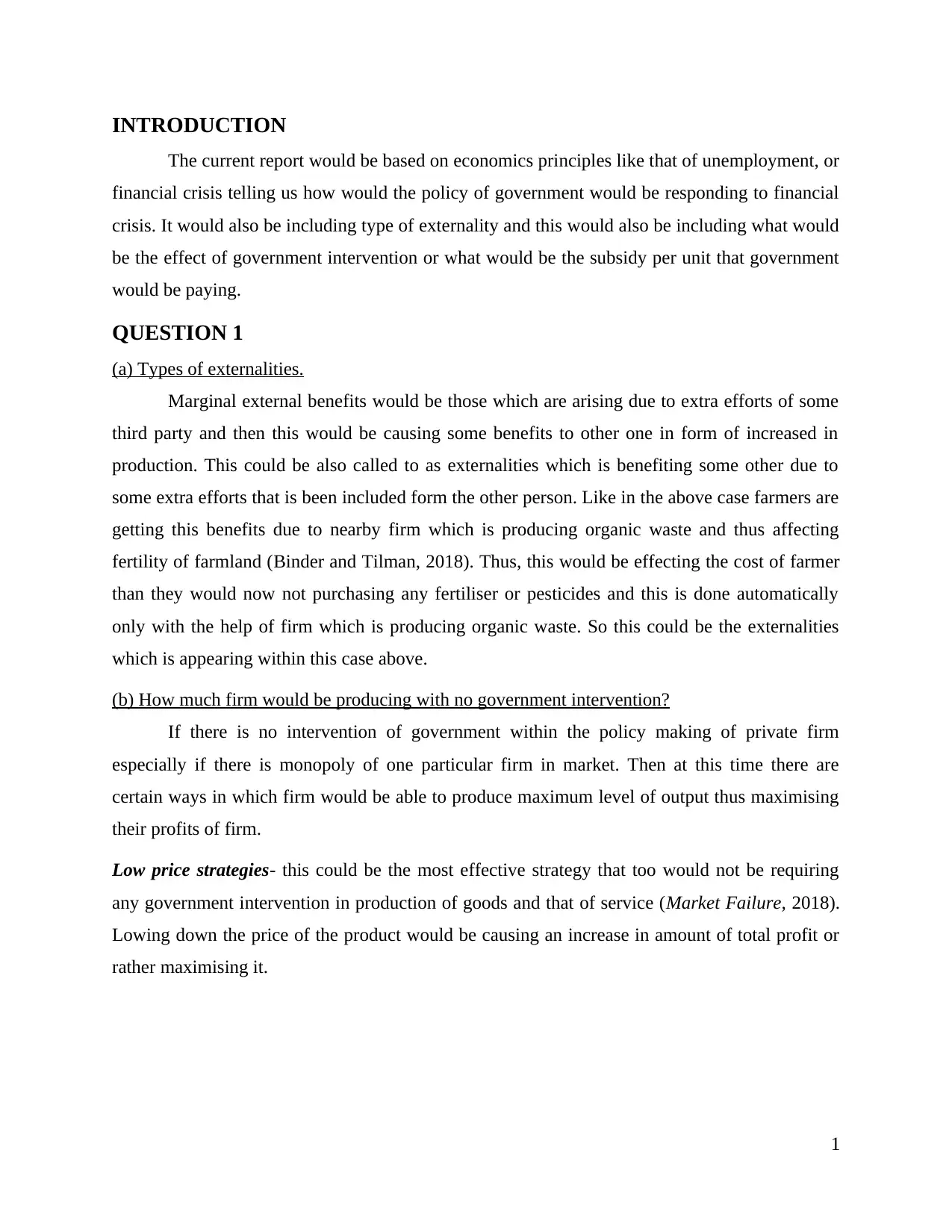
INTRODUCTION
The current report would be based on economics principles like that of unemployment, or
financial crisis telling us how would the policy of government would be responding to financial
crisis. It would also be including type of externality and this would also be including what would
be the effect of government intervention or what would be the subsidy per unit that government
would be paying.
QUESTION 1
(a) Types of externalities.
Marginal external benefits would be those which are arising due to extra efforts of some
third party and then this would be causing some benefits to other one in form of increased in
production. This could be also called to as externalities which is benefiting some other due to
some extra efforts that is been included form the other person. Like in the above case farmers are
getting this benefits due to nearby firm which is producing organic waste and thus affecting
fertility of farmland (Binder and Tilman, 2018). Thus, this would be effecting the cost of farmer
than they would now not purchasing any fertiliser or pesticides and this is done automatically
only with the help of firm which is producing organic waste. So this could be the externalities
which is appearing within this case above.
(b) How much firm would be producing with no government intervention?
If there is no intervention of government within the policy making of private firm
especially if there is monopoly of one particular firm in market. Then at this time there are
certain ways in which firm would be able to produce maximum level of output thus maximising
their profits of firm.
Low price strategies- this could be the most effective strategy that too would not be requiring
any government intervention in production of goods and that of service (Market Failure, 2018).
Lowing down the price of the product would be causing an increase in amount of total profit or
rather maximising it.
1
The current report would be based on economics principles like that of unemployment, or
financial crisis telling us how would the policy of government would be responding to financial
crisis. It would also be including type of externality and this would also be including what would
be the effect of government intervention or what would be the subsidy per unit that government
would be paying.
QUESTION 1
(a) Types of externalities.
Marginal external benefits would be those which are arising due to extra efforts of some
third party and then this would be causing some benefits to other one in form of increased in
production. This could be also called to as externalities which is benefiting some other due to
some extra efforts that is been included form the other person. Like in the above case farmers are
getting this benefits due to nearby firm which is producing organic waste and thus affecting
fertility of farmland (Binder and Tilman, 2018). Thus, this would be effecting the cost of farmer
than they would now not purchasing any fertiliser or pesticides and this is done automatically
only with the help of firm which is producing organic waste. So this could be the externalities
which is appearing within this case above.
(b) How much firm would be producing with no government intervention?
If there is no intervention of government within the policy making of private firm
especially if there is monopoly of one particular firm in market. Then at this time there are
certain ways in which firm would be able to produce maximum level of output thus maximising
their profits of firm.
Low price strategies- this could be the most effective strategy that too would not be requiring
any government intervention in production of goods and that of service (Market Failure, 2018).
Lowing down the price of the product would be causing an increase in amount of total profit or
rather maximising it.
1
⊘ This is a preview!⊘
Do you want full access?
Subscribe today to unlock all pages.

Trusted by 1+ million students worldwide

So in order to earn the maximum profits the firm would be producing at that level where
both MC and MR are equal. Which is firm is producing 7 units of output to maximise its profits
where both price and marginal cost would be equal to 20.
(c) Socially optimum level of output
The socially optimum level of output would be 8 on which price and marginal social cost I equal
to 20.
Social efficiency: could be defined to that situations were the price of a product would be equal
to that marginal cost and this is maximising profits of the firm. Which would be called as the
society is having optimum resources to get distributed among people. P=MC.
(d) Welfare lost without government intervention
Externalities
2
Price (£)
Marginal social
cost (£)
both MC and MR are equal. Which is firm is producing 7 units of output to maximise its profits
where both price and marginal cost would be equal to 20.
(c) Socially optimum level of output
The socially optimum level of output would be 8 on which price and marginal social cost I equal
to 20.
Social efficiency: could be defined to that situations were the price of a product would be equal
to that marginal cost and this is maximising profits of the firm. Which would be called as the
society is having optimum resources to get distributed among people. P=MC.
(d) Welfare lost without government intervention
Externalities
2
Price (£)
Marginal social
cost (£)
Paraphrase This Document
Need a fresh take? Get an instant paraphrase of this document with our AI Paraphraser

Welfare lost
P1 = 20
P2 = 26
Q0 = 10
Q1 = 8
Welfare loss = ½ (P2-P1) x (Q0-Q1)
= ½ (26-20) x (10-8)
3
P1 = 20
P2 = 26
Q0 = 10
Q1 = 8
Welfare loss = ½ (P2-P1) x (Q0-Q1)
= ½ (26-20) x (10-8)
3
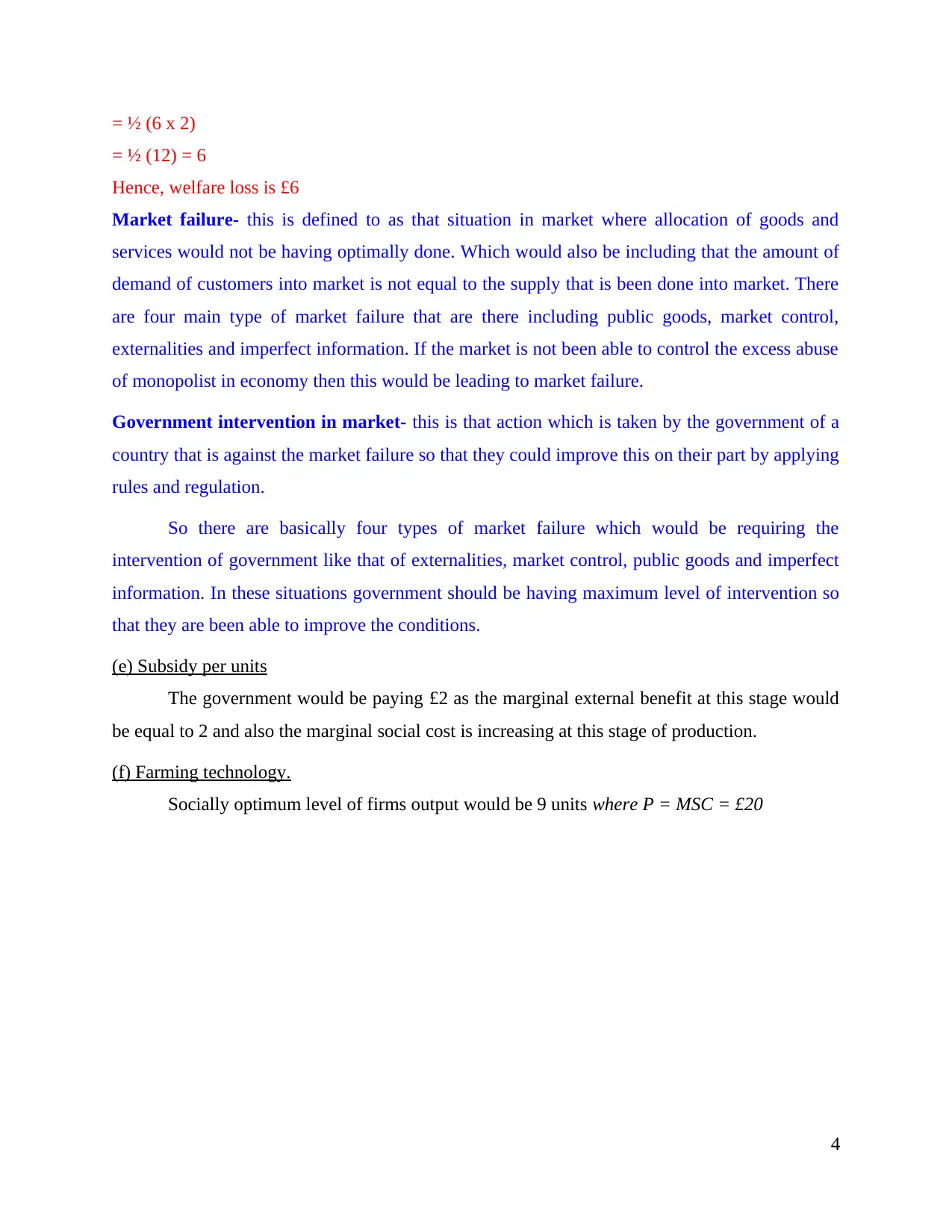
= ½ (6 x 2)
= ½ (12) = 6
Hence, welfare loss is £6
Market failure- this is defined to as that situation in market where allocation of goods and
services would not be having optimally done. Which would also be including that the amount of
demand of customers into market is not equal to the supply that is been done into market. There
are four main type of market failure that are there including public goods, market control,
externalities and imperfect information. If the market is not been able to control the excess abuse
of monopolist in economy then this would be leading to market failure.
Government intervention in market- this is that action which is taken by the government of a
country that is against the market failure so that they could improve this on their part by applying
rules and regulation.
So there are basically four types of market failure which would be requiring the
intervention of government like that of externalities, market control, public goods and imperfect
information. In these situations government should be having maximum level of intervention so
that they are been able to improve the conditions.
(e) Subsidy per units
The government would be paying £2 as the marginal external benefit at this stage would
be equal to 2 and also the marginal social cost is increasing at this stage of production.
(f) Farming technology.
Socially optimum level of firms output would be 9 units where P = MSC = £20
4
= ½ (12) = 6
Hence, welfare loss is £6
Market failure- this is defined to as that situation in market where allocation of goods and
services would not be having optimally done. Which would also be including that the amount of
demand of customers into market is not equal to the supply that is been done into market. There
are four main type of market failure that are there including public goods, market control,
externalities and imperfect information. If the market is not been able to control the excess abuse
of monopolist in economy then this would be leading to market failure.
Government intervention in market- this is that action which is taken by the government of a
country that is against the market failure so that they could improve this on their part by applying
rules and regulation.
So there are basically four types of market failure which would be requiring the
intervention of government like that of externalities, market control, public goods and imperfect
information. In these situations government should be having maximum level of intervention so
that they are been able to improve the conditions.
(e) Subsidy per units
The government would be paying £2 as the marginal external benefit at this stage would
be equal to 2 and also the marginal social cost is increasing at this stage of production.
(f) Farming technology.
Socially optimum level of firms output would be 9 units where P = MSC = £20
4
⊘ This is a preview!⊘
Do you want full access?
Subscribe today to unlock all pages.

Trusted by 1+ million students worldwide

QUESTION 2
(a) Filling the value.
(b) Equilibrium level of national income.
Where the aggregate demand and supply curve would be equal. So in the above case this
equilibrium would be at £1200 as both are equal to £1200.
1 2 3 4 5 6 7 8 9 10
0
200
400
600
800
1000
1200
1400
1600
1800
2000
5
aggregate demand (y)
aggregate expenditure (e)
(a) Filling the value.
(b) Equilibrium level of national income.
Where the aggregate demand and supply curve would be equal. So in the above case this
equilibrium would be at £1200 as both are equal to £1200.
1 2 3 4 5 6 7 8 9 10
0
200
400
600
800
1000
1200
1400
1600
1800
2000
5
aggregate demand (y)
aggregate expenditure (e)
Paraphrase This Document
Need a fresh take? Get an instant paraphrase of this document with our AI Paraphraser

Illustration 1: A monopolistic producing less than optimum
[Source: Leibowicz, 2018]
(c) Expenditure multiplier.
This would be measure of aggregate production which is changed due to change in
expenditure this would be inversely related to the aggregate expenditure (Leibowicz, 2018).
Whereas marginal propensity to consume domestic output would be (MPCd) would be the
change in consumption of domestic output to change in income.
6
[Source: Leibowicz, 2018]
(c) Expenditure multiplier.
This would be measure of aggregate production which is changed due to change in
expenditure this would be inversely related to the aggregate expenditure (Leibowicz, 2018).
Whereas marginal propensity to consume domestic output would be (MPCd) would be the
change in consumption of domestic output to change in income.
6
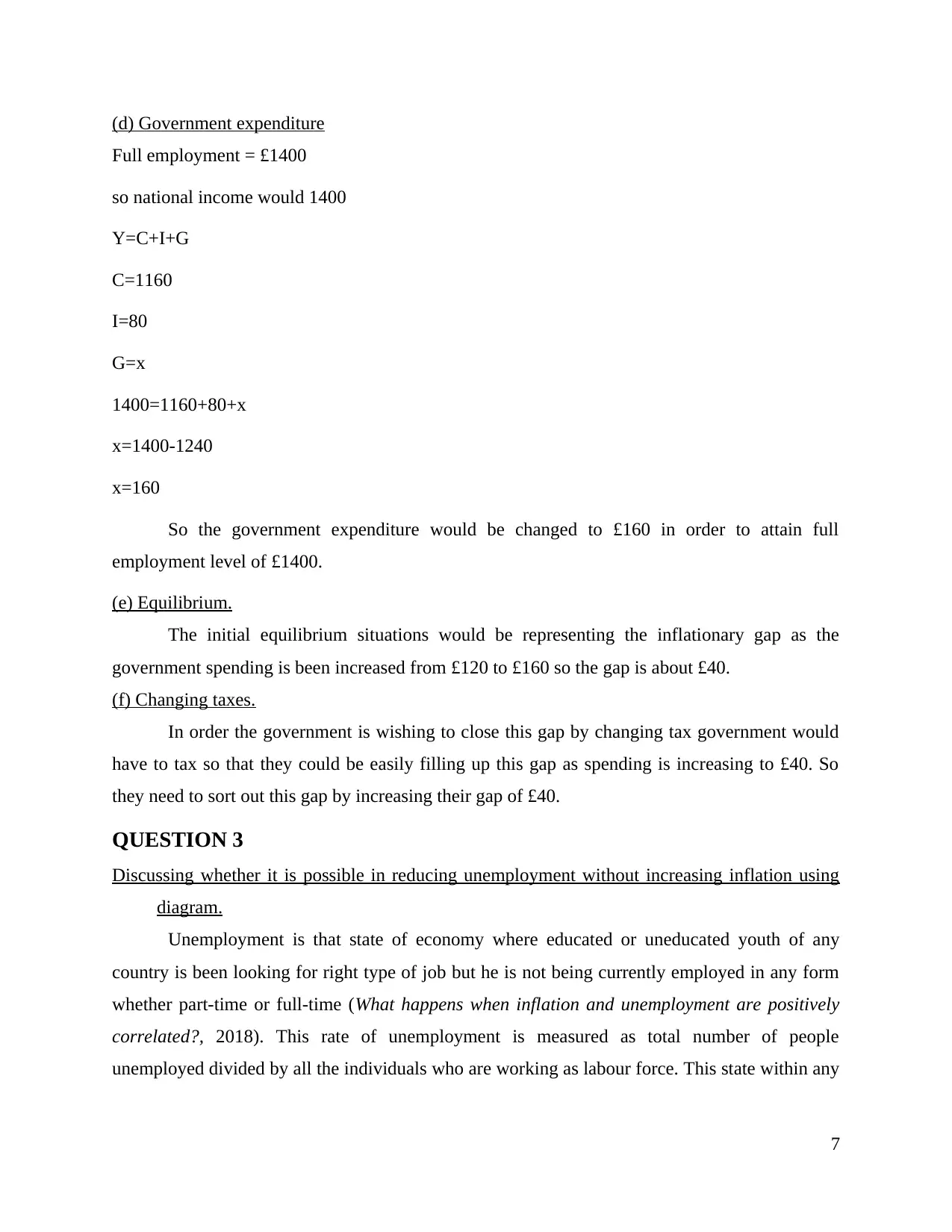
(d) Government expenditure
Full employment = £1400
so national income would 1400
Y=C+I+G
C=1160
I=80
G=x
1400=1160+80+x
x=1400-1240
x=160
So the government expenditure would be changed to £160 in order to attain full
employment level of £1400.
(e) Equilibrium.
The initial equilibrium situations would be representing the inflationary gap as the
government spending is been increased from £120 to £160 so the gap is about £40.
(f) Changing taxes.
In order the government is wishing to close this gap by changing tax government would
have to tax so that they could be easily filling up this gap as spending is increasing to £40. So
they need to sort out this gap by increasing their gap of £40.
QUESTION 3
Discussing whether it is possible in reducing unemployment without increasing inflation using
diagram.
Unemployment is that state of economy where educated or uneducated youth of any
country is been looking for right type of job but he is not being currently employed in any form
whether part-time or full-time (What happens when inflation and unemployment are positively
correlated?, 2018). This rate of unemployment is measured as total number of people
unemployed divided by all the individuals who are working as labour force. This state within any
7
Full employment = £1400
so national income would 1400
Y=C+I+G
C=1160
I=80
G=x
1400=1160+80+x
x=1400-1240
x=160
So the government expenditure would be changed to £160 in order to attain full
employment level of £1400.
(e) Equilibrium.
The initial equilibrium situations would be representing the inflationary gap as the
government spending is been increased from £120 to £160 so the gap is about £40.
(f) Changing taxes.
In order the government is wishing to close this gap by changing tax government would
have to tax so that they could be easily filling up this gap as spending is increasing to £40. So
they need to sort out this gap by increasing their gap of £40.
QUESTION 3
Discussing whether it is possible in reducing unemployment without increasing inflation using
diagram.
Unemployment is that state of economy where educated or uneducated youth of any
country is been looking for right type of job but he is not being currently employed in any form
whether part-time or full-time (What happens when inflation and unemployment are positively
correlated?, 2018). This rate of unemployment is measured as total number of people
unemployed divided by all the individuals who are working as labour force. This state within any
7
⊘ This is a preview!⊘
Do you want full access?
Subscribe today to unlock all pages.

Trusted by 1+ million students worldwide

economy is largely noticed at the time of recession period where there are no jobs for the
individuals who are eligible or educated both.
On the other hand inflation is that situation in an economy where prices of goods and
service in market are increased to their maximum level over a time period. With this the
purchasing power of currency tends to be decreasing gradually and loss in the real value of
exchange. Practically both these phenomena which is unemployment and inflation is having
inverse relationship which means that if one is increasing other would be decreasing and vice
versa. Whereas both these terms are having negative effects on the economy of any nation if they
are been prolonged in long run. This relationship of both could be trade-off between them which
is called to as Phillips curve which is depicting both these on one graph.
It could also argued that whether it is possible to reduce unemployment that too without
increasing inflation. This would be depending upon the fiscal policy within that country stating
positive relationship between both this would be boosting up economic output and the reducing
the unemployment (Koeniger and Prat, 2018). But according to Phillips curve it was stated that
lower level of unemployment would be depicting higher level of inflation rate within the country
and the vice versa. However, the positive relationship between both would only be possible in
case where government is making stronger fiscal policy in regard to both inflation and
unemployment. This was seen in 1970 in USA where both were positively correlated called to as
stagflation but there must be greater efforts of the fiscal policy makers of government.
Otherwise, this is not really possible that unemployment could be reduced without making any
changes in inflation rate of economy especially in long run.
QUESTION 4
Explaining the policy that is responding to financial crisis in UK and critically evaluating it with
use of theory and evidence.
During the financial crisis of 2007-09 which was hitting the whole economy of UK and
the rest of the world liquidity in country was losing up, credit flow was slowing down and
problem within financial system was spilling over to the real economy. At this time various
governments of countries were trying to get over this crisis by introducing many fiscal and
monetary policy. These policies tend to respond to all financial crisis within the economy of UK
in which European Central Bank played the most remarkable role.
8
individuals who are eligible or educated both.
On the other hand inflation is that situation in an economy where prices of goods and
service in market are increased to their maximum level over a time period. With this the
purchasing power of currency tends to be decreasing gradually and loss in the real value of
exchange. Practically both these phenomena which is unemployment and inflation is having
inverse relationship which means that if one is increasing other would be decreasing and vice
versa. Whereas both these terms are having negative effects on the economy of any nation if they
are been prolonged in long run. This relationship of both could be trade-off between them which
is called to as Phillips curve which is depicting both these on one graph.
It could also argued that whether it is possible to reduce unemployment that too without
increasing inflation. This would be depending upon the fiscal policy within that country stating
positive relationship between both this would be boosting up economic output and the reducing
the unemployment (Koeniger and Prat, 2018). But according to Phillips curve it was stated that
lower level of unemployment would be depicting higher level of inflation rate within the country
and the vice versa. However, the positive relationship between both would only be possible in
case where government is making stronger fiscal policy in regard to both inflation and
unemployment. This was seen in 1970 in USA where both were positively correlated called to as
stagflation but there must be greater efforts of the fiscal policy makers of government.
Otherwise, this is not really possible that unemployment could be reduced without making any
changes in inflation rate of economy especially in long run.
QUESTION 4
Explaining the policy that is responding to financial crisis in UK and critically evaluating it with
use of theory and evidence.
During the financial crisis of 2007-09 which was hitting the whole economy of UK and
the rest of the world liquidity in country was losing up, credit flow was slowing down and
problem within financial system was spilling over to the real economy. At this time various
governments of countries were trying to get over this crisis by introducing many fiscal and
monetary policy. These policies tend to respond to all financial crisis within the economy of UK
in which European Central Bank played the most remarkable role.
8
Paraphrase This Document
Need a fresh take? Get an instant paraphrase of this document with our AI Paraphraser

Monetary policy-
At the time of recession of 2007 ECU cut down their policy rate by about 325 points
since October 2008 when the financial crisis were leading to decline in inflationary pressure. As
liquidity was urgently needed so ECU lowered down the interest policy rate so that they could
resort to highly non standard liquidity operations (The economic crisis and the response of fiscal
and monetary policy, 2018). A wide range of measures were being employed just in order to
lower down effects of financial and economies crisis.
Fiscal policy-
At this time it was important that government was supporting the banking sector so that
financial stability could be maintained. Which included that government was guaranteeing the
interbank lending, recapitalisation, increasing coverage of retail deposit insurance and asset relief
schemes. These all impacted only small direct effect on government deficit and on debt it was
seen which increased the GDP to 3% and liabilities increasing GDP to 8% but all these did not
included government guarantee on retail deposit in banks.
9
At the time of recession of 2007 ECU cut down their policy rate by about 325 points
since October 2008 when the financial crisis were leading to decline in inflationary pressure. As
liquidity was urgently needed so ECU lowered down the interest policy rate so that they could
resort to highly non standard liquidity operations (The economic crisis and the response of fiscal
and monetary policy, 2018). A wide range of measures were being employed just in order to
lower down effects of financial and economies crisis.
Fiscal policy-
At this time it was important that government was supporting the banking sector so that
financial stability could be maintained. Which included that government was guaranteeing the
interbank lending, recapitalisation, increasing coverage of retail deposit insurance and asset relief
schemes. These all impacted only small direct effect on government deficit and on debt it was
seen which increased the GDP to 3% and liabilities increasing GDP to 8% but all these did not
included government guarantee on retail deposit in banks.
9
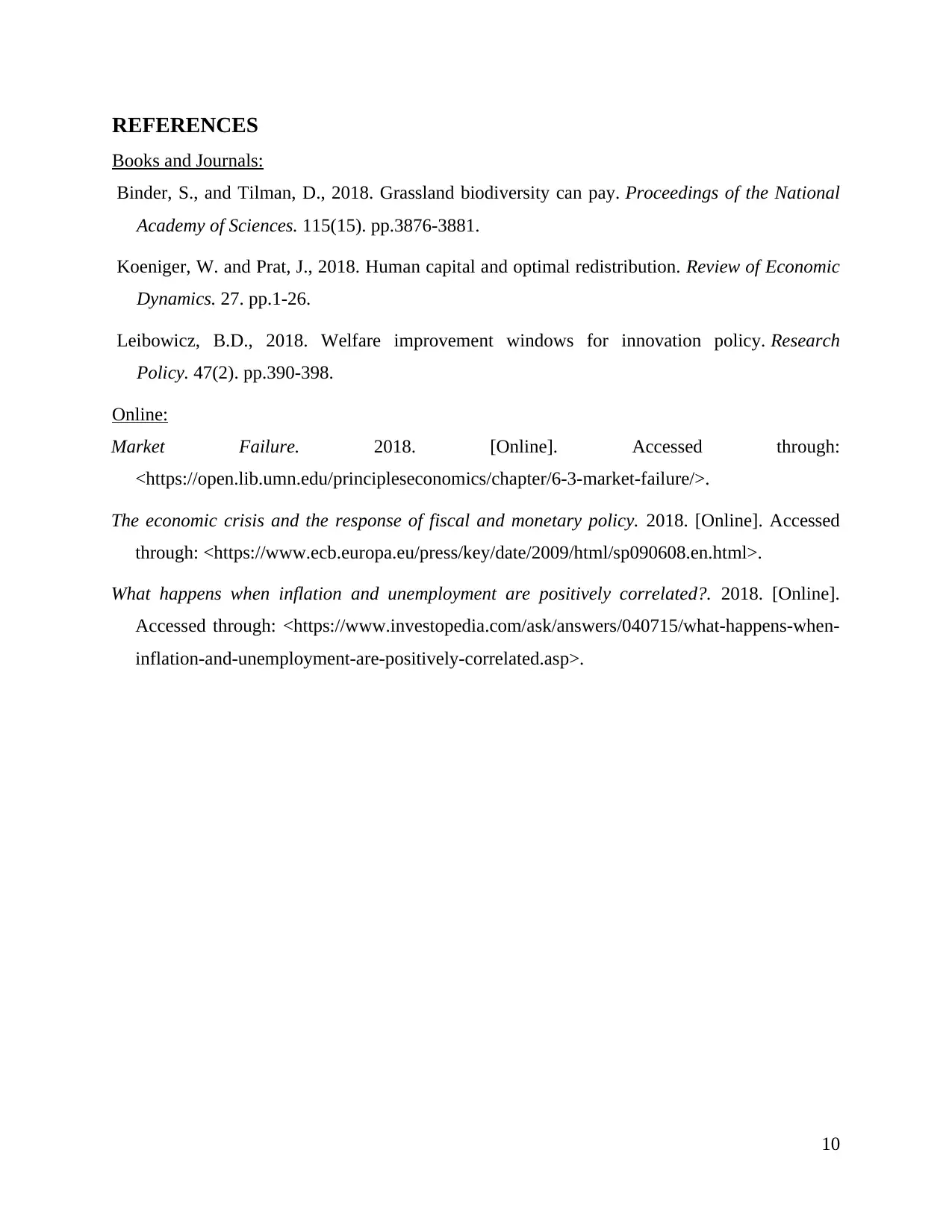
REFERENCES
Books and Journals:
Binder, S., and Tilman, D., 2018. Grassland biodiversity can pay. Proceedings of the National
Academy of Sciences. 115(15). pp.3876-3881.
Koeniger, W. and Prat, J., 2018. Human capital and optimal redistribution. Review of Economic
Dynamics. 27. pp.1-26.
Leibowicz, B.D., 2018. Welfare improvement windows for innovation policy. Research
Policy. 47(2). pp.390-398.
Online:
Market Failure. 2018. [Online]. Accessed through:
<https://open.lib.umn.edu/principleseconomics/chapter/6-3-market-failure/>.
The economic crisis and the response of fiscal and monetary policy. 2018. [Online]. Accessed
through: <https://www.ecb.europa.eu/press/key/date/2009/html/sp090608.en.html>.
What happens when inflation and unemployment are positively correlated?. 2018. [Online].
Accessed through: <https://www.investopedia.com/ask/answers/040715/what-happens-when-
inflation-and-unemployment-are-positively-correlated.asp>.
10
Books and Journals:
Binder, S., and Tilman, D., 2018. Grassland biodiversity can pay. Proceedings of the National
Academy of Sciences. 115(15). pp.3876-3881.
Koeniger, W. and Prat, J., 2018. Human capital and optimal redistribution. Review of Economic
Dynamics. 27. pp.1-26.
Leibowicz, B.D., 2018. Welfare improvement windows for innovation policy. Research
Policy. 47(2). pp.390-398.
Online:
Market Failure. 2018. [Online]. Accessed through:
<https://open.lib.umn.edu/principleseconomics/chapter/6-3-market-failure/>.
The economic crisis and the response of fiscal and monetary policy. 2018. [Online]. Accessed
through: <https://www.ecb.europa.eu/press/key/date/2009/html/sp090608.en.html>.
What happens when inflation and unemployment are positively correlated?. 2018. [Online].
Accessed through: <https://www.investopedia.com/ask/answers/040715/what-happens-when-
inflation-and-unemployment-are-positively-correlated.asp>.
10
⊘ This is a preview!⊘
Do you want full access?
Subscribe today to unlock all pages.

Trusted by 1+ million students worldwide
1 out of 12
Related Documents
Your All-in-One AI-Powered Toolkit for Academic Success.
+13062052269
info@desklib.com
Available 24*7 on WhatsApp / Email
![[object Object]](/_next/static/media/star-bottom.7253800d.svg)
Unlock your academic potential
Copyright © 2020–2025 A2Z Services. All Rights Reserved. Developed and managed by ZUCOL.





